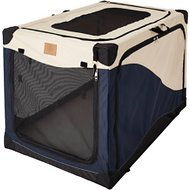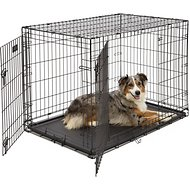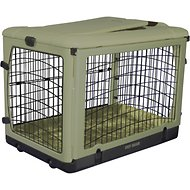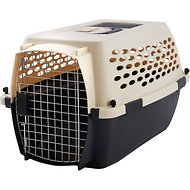5 Best Labrador Crates: Our 2025 Labrador Crate Size Guide
Quick Guide
Labrador Retrievers are one of the most popular dog breeds out there, thanks to their loyalty, playful spirit, and family-friendly attitude. But whether you have a young Lab pup that is just learning to become house trained, or an older dog that has not yet been crate trained, you may be wondering what the best Labrador crates for 2025 might be.
In this guide, we’ll provide you with an in-depth look at the most popular types of Labrador crates, discuss a few of the top products on the market, answer questions about crate sizing and training, and much more.
After you’ve read this guide, you’ll have all of the information that you need to purchase a high-quality Labrador crate, and make sure that your dog enjoys its new home. Let’s get started now.
What is the Best Crate for a Labrador?
Popular Types of Crates For Labradors
First, let’s discuss the basic types of dog crates that are available for Labradors. The most popular types of crate include the following options:
- Folding wire crates – These are, by far, the most common type of dog crate, and the type that you are probably already familiar with. They are typically made of thick-gauge steel, and are foldable and collapsible for transportation. Most folding wire crates also come with a plastic pan which sits on the bottom of the crate, providing a floor for your dog, and come with a divider that can make the crate smaller or bigger as your dog grows.
- Heavy-duty crates – Heavy-duty crates are a great option for dogs that tend to escape their crates, whether purposely or accidentally. They use a thicker, more reinforced wire compared to standard folding wire crates, and usually have a more robust latching and locking mechanism, and strong hinges to hold up to strong dogs.
- Soft-sided crates – While they are useful for travel, soft-sided crates are not usually a good option until your dog has been properly crate-trained. This is because they are made of a canvas or nylon material stretched over an internal frame, sort of like a tent. While this provides a safe, comfortable spot for your dog to relax, the fabric is not very resistant to chewing or biting. However, they are a great option for travel if your dog is properly crate-trained and does not usually try to escape its crate.
- Plastic portable dog crates – This type of crate is suited mostly for air travel, and is usually not ideal for day-to-day use, because they are usually a bit more restrictive than wire crates and soft-sided crates, and are quite expensive. Plastic portable dog crates have durable, hard plastic sides with wire doors and vents.
These four types of crates are the most common for Labradors, and the right type of crate for you depends on your dog’s preferences, whether or not it’s been housetrained, how often you travel with your Labrador, and a number of other factors – so think about all these things when you’re picking out a crate for your pup!
How to Determine The Correct Labrador Crate Size
An important factor in choosing the best dog crate for a Labrador is determining the right Labrador crate size. Your dog’s crate should be large enough that it can easily sit, lay down, and turn around. To measure your dog and make sure you get a properly-sized crate, here’s what you should do:
- Measure its length from the tip of its nose to the end of its tail, and add 2-4 inches
- Measure its height when it’s sitting to determine the proper height for its crate
- Measure the width of its body and add 4 inches
Most crates for sale online have their dimensions listed, and also have a weight recommendation or breed recommendation, so take this information into account when selecting a crate.
Choosing the right size of crate for your dog is critical for a number of reasons. But, first, and foremost, it helps ensure your dog is crate trained properly. The whole idea of crate training is that, because dogs do not like to soil their bedding and sleep area, confining them in a small space will encourage them to “hold it.”
Overall Best Crates for Labradors
| Our 2025 Picks: Best Dog Crates for Labradors | |||
Frisco Fold & Carry Single Door Dog Crate
|
CHECK PRICE | ||
Precision Pet Products Soft Sided Crate
|
CHECK PRICE | ||
MidWest ICrate Double Door Fold & Carry Dog Crate
|
CHECK PRICE | ||
Pet Gear The Other Door Steel Crate & Plush Pad, Sage
|
CHECK PRICE | ||
Frisco Plastic Kennel, Almond & Black
|
CHECK PRICE | ||
Frisco Fold & Carry Single Door Dog Crate
Key Features:
- Affordable and cost-effective
- Comes with plastic tray and divider
- Secure, double-latching mechanism
- Built of high-grade steel
Overall Best Crate For A Labrador –Sometimes, the basics are best. The overall best crate for your Labrador is this Frisco crate, which is collapsible and foldable, and comes with a durable plastic tray and a convenient divider, so that it can be used for puppies of all ages. Built of electro-coated steel, it’s rust resistant, and sure to hold up to wear and tear.
Pros:
- Lightweight and easy to transport
- Does not require tools to assemble
- Great value
Cons:
- Initial assembly can be a bit difficult
- Latches may not hold up to heavy abuse by escape-prone dogs
- Requires a bit of practice to fold up properly
Precision Pet Products Soft Sided Crate
Key Features:
- Comfortable, soft-sided design
- Reinforced corners for durability
- Plentiful ventilation
- Included water bottle holder
Best Travel Crate For A Labrador – For travel, such as road trips, outdoor excursions and staying in hotels, this soft-sided crate is a great option. It’s comfortable, lightweight, and strong thanks to its metal frame and high-quality nylon and mesh construction. However, it’s not a good option for dogs that chew or scratch, and should only be used after your dog has been trained in a traditional, wire crate.
Pros:
- Sturdy frame and durable nylon
- High-quality zippers
- Easy to collapse and transport
Cons:
- Expensive
- Not good for dogs that tend to chew or scratch
- Should not be used for dogs that are not fully crate trained
MidWest iCrate Double Door Fold & Carry Dog Crate
Key Features:
- Double door entry
- Rubber rollers to prevent damage to floors
- Included divider and pan
- Foldable for easy transport
Best 42 Inch Crate For A Labrador –If you’re looking for the best 42-inch crate for your Labrador, this would be our top pick. It’s more expensive than our top pick, the Frisco crate, but has some features like double doors and rubber floor rollers which make it worth the investment. It’s foldable, and even comes with plastic carrying handles to make packing and moving the create easier.
Pros:
- Top quality steel for durability
- Can accommodate even the largest Labradors
- Professional-gauge latches for peace of mind
Cons:
- More expensive than most 42-inch crates
- Prone to rust in damp environments
- Should not be moved when your dog is inside
2 More Labrador Crates
Want more options? The following Labrador crates didn’t quite make it to the top of the list, but still may be a good option for you and your Lab, depending on your needs. Take a look now.
Pet Gear The Other Door Steel Crate & Plush Pad, Sage
Key Features:
- No sharp corners or wires
- Four doors for easy placement in any room
- Plush bolster bed
- Built-in wheels and handle
This crate is a unique hybrid of a plastic and metal crate, and is a good option if you’re worried that your dog may be harmed by sharp wire corners. It features four doors, plenty of ventilation, and a plush pad that’s comfortable for your Lab.
Pros:
- Easy to transport
- Insulated base
- Comfortable bed comes with the crate
Cons:
- Does not have a plastic liner, should not be used with Labs that are not housebroken
- Quite heavy
- Extremely expensive compared to our other picks
Frisco Plastic Kennel, Almond & Black
Key Features:
- Built with two strong grooves for handling
- Strong plastic shell
- Plentiful ventilation
- Durable metal door
If you’re flying with your Lab, or just want a highly-secure kennel to use when going to the vet or on roadtrips, this plastic kennel from Frisco is a great option. It’s available in both large and x-large sizes to fit even the biggest Labradors. The strong plastic is vented for comfort, and it features a strong latch and an interior plastic mat that’s easy to clean. In addition, it can be quickly disassembled into two halves for storage.
Pros:
- Great for air travel
- Simple assembly, disassembly
- Easy to clean
Cons:
- Not resistant to strong chewing
- Hinges are relatively weak
- No top handle
5 Tips For Crate Training A Labrador Puppy
If you’re crate training your Labrador puppy for the first time, you may have some questions about the process, so we’re here with some tips that will help you train your dog humanely and successfully. Read on, and learn more.
- Don’t rush your Lab into its crate – Don’t just put your dog into its crate and lock it up immediately. Take things slowly. Put bedding and toys in your Labrador’s crate, and introduce it to the crate without closing the door. Drop some treats or a toy in the crate to encourage it to go in, and encourage your pup as it goes in. Do this for a few days, until your dog is willing to go all the way into the crate.
Once your dog will go into its crate willingly, you can lock the door behind your Labrador, and leave in there for a few minutes at a time, as it gets used to the crate. Over the next few days, you can start leaving your dog in its crate for longer periods of time, working up to multiple hours. Don’t move things along too quickly – if your dog seems unhappy or nervous, let it out, and give it more time to get used to the crate. - Feed your dog its meals in the crate – This is a great next step after introducing your dog to the crate. Put its food and water in the crate, and lock the door behind your Labrador as it eats. At first, you can open the door as soon as it’s finished eating. But over time, you can leave it closed for a longer period of time, as your dog gets used to its crate.
- Don’t use your crate as a punishment – Your dog’s crate is supposed to be a safe, comfortable environment, so don’t punish your dog by locking it in the crate. It will begin to associate negativity with its crate, which can impair the crate training process.
- Make your Labrador’s crate comfortable – Line your dog’s crate with bedding and put toys inside, as well as a water dish. You may also want to use a crate cover to darken the environment, as some Labradors prefer a dark area where they can nap.
- Don’t make a big deal about leaving and coming home – Once your dog can stay in its crate for a prolonged period of time, and you’re leaving the house for an extended period of time, you should start crating your Labrador about 5-20 minutes before you leave, then depart without a fuss.The same thing is true of arriving home. Don’t greet your dog enthusiastically. Instead, remain low key, and let your dog out after you’ve been home for about 10-20 minutes. You should also crate your dog occasionally for short periods of time when you’re at home. Doing this will help ensure that your dog does not associate being crated with being left alone. Crating will just become part of its day-to-day routine, not a sign of abandonment.
FAQs About Labrador Crates
Got questions about Labrador crates and crate training? We’ve got answers. Take a look at these common FAQs about Labrador crates now.
- How long should I crate train my Labrador puppy at night? When your puppy is less than 9 weeks old, you should let it out of its crate to go potty about every 3 hours at night. As your puppy gets older and reaches 9-12 weeks of age, it will be able to hold its bladder more effectively, so you can stretch this to a single break after about 4 hours after it goes to sleep. Once your puppy reaches 12 weeks, it should be able to get through the whole night without an accident, but you should work up to this slowly, to ensure your dog gets used to sleeping through the whole night without a potty break.
- Why shouldn’t my Labrador wear its collar inside its crate? Collars can get caught on metal bars in crates, and pose a strangulation risk. For that reason, you should never let your dog wear the collar while it is being crated.
- Is crating inhumane or bad for my dog? Not at all! Crating is a great way to housebreak your dog. When you crate-train your dog properly, it will think of its crate as a cozy bedroom or den where it can feel safe and relax. However, crating can be bad for your dog if you do it wrong. Your dog should not be locked up for more than 8 hours at most. Dogs, just like people, are not meant to spend their whole lives confined to a little room!
- Is it better to buy multiple crates, or a crate with a divider? If you’re raising a Labrador puppy, we would recommend that you buy a crate that will fit your adult dog, such as a 42-inch crate. Then, you can use a divider to create a properly-sized area for your puppy, and expand it as your dog grows. This will save you a lot of money, compared to buying multiple crates as your dog grows. It also helps your dog get used to its crate, which is more difficult if you are swapping out each crate every few months.
- Can I train an older Labrador to use a crate? Of course! It’s never too late to crate-train your dog. Buy a crate and follow proper crate-training procedures, and you’ll be surprised at how quickly your old dog can learn new tricks!
Got more questions about buying a crate and crate training? We recommend consulting with other online resources, or meeting with a pet trainer or behaviorist!
Conclusion
After reading this guide, you’re sure to pick the right crate for your Labrador. So take another look at the information in this guide, think about which type of crate might be right for your dog, and check out our product recommendations – and get a crate that’s perfect for you and your pup.















